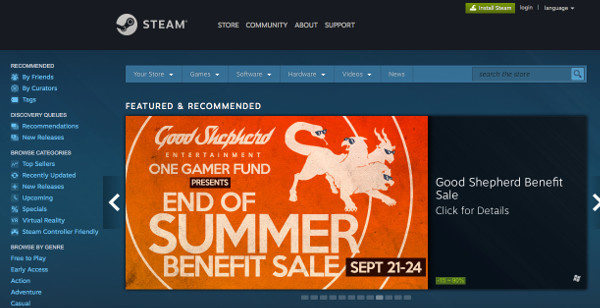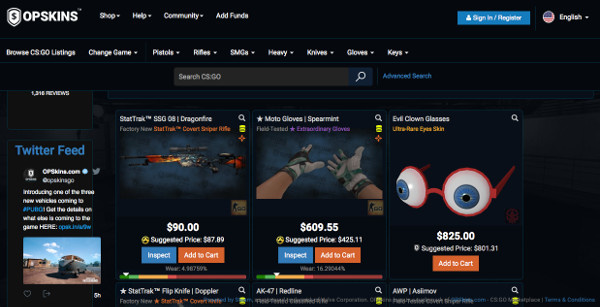How to legalize the sale of game items

The volume of the Russian online gaming market at the end of 2016 amounted to 56.7 billion rubles. (according to Mail.Ru Group), the global volume of the online gaming market in 2016 is $ 99.6 billion (according to Newzoo), but only 6% of users can earn money on in-game items. Game spaces offer to actively buy ammunition, camouflage, character's progress, but you cannot legally sell your collection to someone, as you cannot and get money out of the game, having invested time, skills and luck.
Having extensive experience in the gaming industry (Suntechsoft, Esforce, Na'Vi ', etc.), we figured out how to combine all the games and platforms and give gamers the opportunity to sell, exchange or evaluate virtual items in one click. The DMarket service will work on the blockchain base, and all operations within the marketplace can be performed using embedded tokens and smart contracts.
')
But first, we would like to talk about why the need for such a project is really overdue.
From virtual to real
Many collect collections of things, weapons, artifacts in video games just as others offline collect coins, stamps and weapons from different countries. We calculated: 2.15 billion gamers in the world are facing a technological limitation of their right to trade in-game items. Spending time and effort, they earn virtual items on computers, phones or consoles. These items have real value, are rare, attractive, and sometimes just needed by other gamers. But everything virtual continues to be virtual.
Of course, users started inventing different scenarios in order to get real benefits from their virtual life. They convert a lot of game items into one expensive one and sell it, buy game keys for game items and, again, sell them. Finally, they simply agree with other users on the forums and transfer items or entire accounts there. Of course, the issue of security of transactions is provided very conditionally, so often both sellers and buyers are faced with fraud.
“Honest game projects and platforms with the possibility of legal withdrawal of funds from the ecosystem is not commonplace. Those that offer to “earn” in the game are more financial pyramids than real games . ”
Consider the largest players in the global in-game items market.
Steam
Daily number of active users: 12,853,536 (as of 07/15/2017);
Number of games: + - 14 398 (as of 07/15/2017).

The Steam platform was released in 2003. Over the past 4 years, it has gained immense popularity among the gaming community, profits in 2016 - $ 3.5 billion. Steam was the first to pay attention to the trade in in-game items. True, all the profits earned are kept inside the platform, there is no possibility to cash out money. Moreover, the ability to trade game items is limited and represented in just a few games (CS: GO, Dota2, TF2, PUBG, H1Z1).
Steam benefits:
- the largest market for selling video games and mods;
- the pace of sales increases, and the catalog of games is rapidly expanding. To date, almost 370 million paid games have been activated;
- Steam offers additional services for players, modders, and game developers: selling items, beta / alpha releases, pre-selling games, register items, processing payments, and checking credit cards.
Steam Disadvantages:
- Steam technologies and servers are centralized and have full control over the availability of each individual product or item in its catalog. This leads to security fraud (account);
- most games on Steam do not support in-game trading. Only three games have a significant impact on the total turnover of in-game items (CS: GO, Dota2, TF2);
- Steam users have no real influence on the development of the platform;
- Steam does not allow its users to cash out the platform’s virtual currency;
- Steam charges a high commission for trading in game items (up to 12%);
- Steam does not support multi-platform trading and trading on different game engines.
Opskins
Opskins is an in-game items trading platform that was launched in 2014. Opskins maintains the safety of both buyers and sellers, acting as a third-party platform. You can withdraw money to your PayPal account, bank account, bitcoin wallet, Visa prepaid card, etc.

The service uses the Steam API, which allows you to trade in-game items. Currently, Opskins is the world's largest skin trading platform with 10 million unique users per month.
Opskins benefits:
- turnover in the first and second quarters of 2017 amounted to about $ 250 million;
- one of the largest communities for the sale of skins (more than 10 million users every month);
- cashing real money.
Opskins Disadvantages:
- does not have official Steam support (a large number of account fraud cases);
- high commission for transactions and withdrawals (up to 10%);
- supports just a few Steam games;
- depends heavily on Steam due to the use of the API interface of this service.
Also on the market there are universal guarantors of transactions, but they work not only with game items, but also with accounts and freelancing, in general. You can go there and sell something individually, but there is no game ecosystem here.
At the beginning of the article we talked about 2.15 billion gamers. This is the number of people around the world who play games on different platforms. If they all had the opportunity to trade their virtual rarities, the annual turnover of game content in monetary terms would have exceeded $ 450 billion.
A logical question arises - why did nobody create such a platform when it comes to such potential? The main problem that previously did not allow us to realize what we have just done is technology. For the universal platform to work, you need to synchronize hundreds of thousands of databases of each game and each publisher after the next transaction. To solve this problem, we use the blockchain database.
The second important point is the interest of game developers and publishers. We do not divert users from buying directly inside the games to buying from private individuals, we create a community in which the sale and exchange of items will be only part of the process. Thanks to the blockchain, the history of each virtual artifact will be saved; it will be possible to trace who owned the conditional machine before, who was the first customer where it was used. This creates a history of each thing, and from a faceless tool to achieve game goals, it turns into a collectible. Users will sell some items and buy others, and then return to the game to use the opportunities they have. Thus, the time spent by the player inside the game, the life of each item and the life cycle of the game itself will increase.
Source: https://habr.com/ru/post/339074/
All Articles